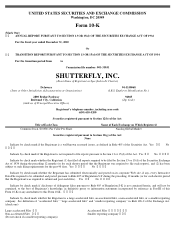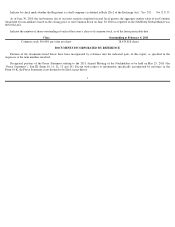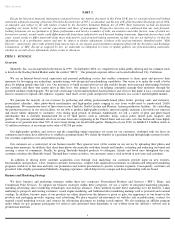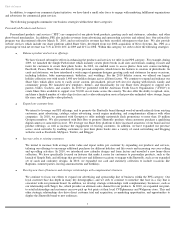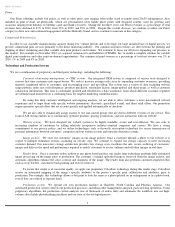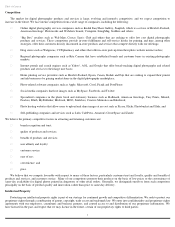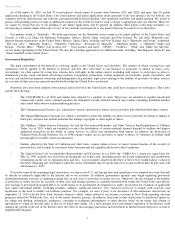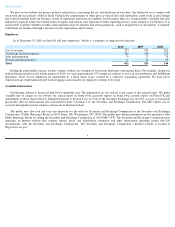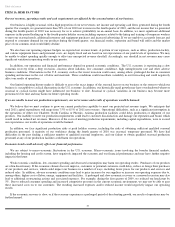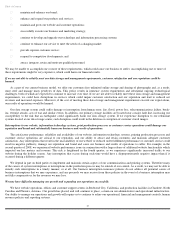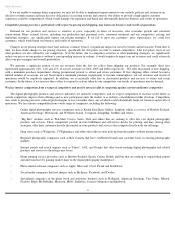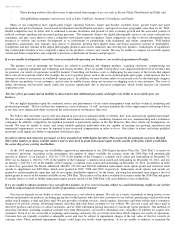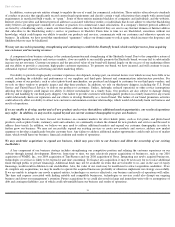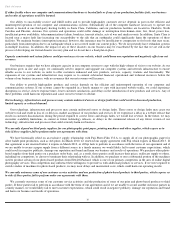Shutterfly 2011 Annual Report Download - page 10
Download and view the complete annual report
Please find page 10 of the 2011 Shutterfly annual report below. You can navigate through the pages in the report by either clicking on the pages listed below, or by using the keyword search tool below to find specific information within the annual report.
As of December 31, 2010, we had 37 issued patents, which expire at various dates between 2019 and 2028, and more than 20 patent
applications pending in the United States. Our issued patents and patent applications relate generally to the user interface for our website, our
computer network infrastructure and software, personalized photo-
related products and automated workflow and digital printing. We intend to
pursue corresponding patent coverage in additional countries to the extent we believe such coverage is appropriate and cost efficient. However,
we cannot be certain that any of our pending or any future applications will be granted. In addition, third parties could bring invalidity, co-
inventorship or similar claims with respect to any of our currently issued patents or any patents that may be issued to us in the future.
Our primary brand is “Shutterfly.”
We hold registrations for the Shutterfly service mark in our major markets of the United States and
Canada, as well as in China, the European Community, Mexico, Brazil, Japan, Australia and New Zealand. We also hold “Shutterfly.com”
Internet domain registrations in the United States, Mexico, Japan, China, Australia and New Zealand, and a “Shutterfly and Design”
trademark,
“Tell your story,” “Shutterfly Express”, “Shutterfly Collections” “Postcards by Shutterfly”, “Shutterfly Studio”, a “
Shutterfly Studio and
Design”, “Picture More,” “Where your pictures live”, “Your pictures and more”, “NEXO”, “VividPics,” “Wink” and “Make one like this”
service mark registrations in the United States. We also have pending applications for additional marks, including “Life Happens. Share It”
and
“Smart AutoFill” in the United States.
Government Regulation
The legal environment of the Internet is evolving rapidly in the United States and elsewhere. The manner in which existing laws and
regulations will be applied to the Internet in general, and how they will relate to our business in particular, is unclear in many cases.
Accordingly, we often cannot be certain how existing laws will apply in the online context, including with respect to such topics as privacy,
defamation, pricing, credit card fraud, advertising, taxation, sweepstakes, promotions, content regulation, net neutrality, quality of products, and
services and intellectual property ownership and infringement. In particular, legal issues relating to the liability of providers of online services
for activities of their users are currently unsettled both within the United States and abroad.
Numerous laws have been adopted at the national and state level in the United States that could have an impact on our business. These laws
include the following:
To resolve some of the remaining legal uncertainty, we expect new U.S. and foreign laws and regulations to be adopted over time that will
be directly or indirectly applicable to the Internet and to our activities. In addition, government agencies may begin regulating previously
unregulated Internet activities or applying existing laws in new ways to providers of online services. Moreover, the law relating to the liability
of providers of online services for activities of their users and business partners is currently unsettled both within the United States and abroad.
Any existing or new legislation applicable to us could expose us to government investigations or audits, prosecution for violations of applicable
laws and/or substantial liability, including penalties, damages, significant attorneys’
fees, expenses necessary to comply with such laws and
regulations or the need to modify our business practices. For example, we were a party to an Assurance of Discontinuance entered into on
September 13, 2010 with the New York Attorney General’
s office, which related to our business activities in New York regarding discount
programs offered by Webloyalty, Inc., one of our former business partners. In addition, from time to time claims may be threatened against us
for aiding and abetting, defamation, negligence, copyright or trademark infringement, or other theories based on the nature and content of
information to which we provide links or that we or others post online. On a more general level, government regulation of the Internet could
dampen the growth in the use of the Internet, have the effect of discouraging innovation and investment in Internet-
based enterprises or lead to
unpredictable litigation.
Table of Contents
● The CAN-
SPAM Act of 2003 and similar laws adopted by a number of states. These laws are intended to regulate unsolicited
commercial e-mails, create criminal penalties for unmarked sexually-oriented material and e-
mails containing fraudulent headers
and control other abusive online marketing practices.
●
The Communications Decency Act, which gives statutory protection to online service providers who distribute third
-
party content.
●
The Digital Millennium Copyright Act, which is intended to reduce the liability of online service providers for listing or linking to
third
-
party websites that include materials that infringe copyrights or other rights of others.
● The Children’
s Online Privacy Protection Act and the Prosecutorial Remedies and Other Tools to End Exploitation of Children
Today Act of 2003, which are intended to restrict the distribution of certain materials deemed harmful to children and impose
additional restrictions on the ability of online services to collect user information from minors. In addition, the Protection of
Children From Sexual Predators Act of 1998 requires online service providers to report evidence of violations of federal child
pornography laws under certain circumstances.
●
Statutes adopted in the State of California and other states, require online services to report certain breaches of the security of
personal data, and to report to consumers when their personal data might be disclosed to direct marketers.
●
The federal Credit Card Accountability Responsibility and Disclosure Act of 2009 (the
“
CARD Act
”
),
which was signed into law
May 22, 2009, includes new provisions governing the use of gift cards, including specific disclosure requirements and a prohibition
or limitation on the use of expiration dates and fees. A recent statute adopted in the State of New Jersey would enforce escheat of
the entire remaining gift card balance when the card is redeemable only for goods and services and would include all gift cards sold
after January 1, 2003.
8


